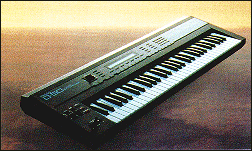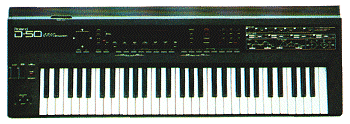
|
Part Two of Newslink's Advanced Synthesizer Course
by David Marshall
Until relatively recently almost all synths
used similar analogue technology. The fundamental sound was created by an
oscillator, with its speed of oscillation (and therefore the pitch) controlled
by the voltage output from a keyboard or similar controller-hence the term
Voltage Controlled Oscillator (VCO).
This was coloured or shaped tonally (by altering
the mix of the fundamental tone and overtones, or harmonics) in a filter
section, again voltage operated STRUCTURE and logically called the Voltage
Controlled Filter (VCF). Finally the volume during the sound's duration could
be shaped using the Voltage Controlled Amplifier (VCA). Sounds derived from
this method of synthesis tend to be very warm and rich, if somewhat unstable
in their tuning.
 |
The first moves towards digital synthesis came
when the VCO was replaced by the Digitally Controlled Oscillator (DCO).
The effects of this were threefold. First, the synthesizer's tuning became
stable. Second, the sound's character changed, the VCO's raw edge being replaced
by the DCO's much cleaner and more precise sound. But most important, the
DCO allowed manufacturers to produce polyphonic synths for the same price
as an old monophonic VCO-equipped model.
Micro-technology changed the whole outlook on
synth design. A bulky circuit board could be replaced by a single chip, giving
greater flexibility at a lower cost, and manufacturers gained the freedom
to experiment with totally new forms of sound creation.
In theory all sound is built from a combination
of sine waves, the sawtooth or square wave's distinctive character being
formed by its mixture of overtones in addition to its fundamental. In analogue
synthesis, reducing the harmonic content of a waveform, using the cut-off
frequency in the VCF section, will eventually lead to a pure sine wave. This
is known as subtractive synthesis. However the first purely digital synth
for the mass market did the opposite by taking a simple sine wave and building
up from it-in other words, additive synthesis.
| mp3 200K |
The Yamaha DX7 used
Frequency
Modulation (FM) as its sound source. FM cast aside traditional synth
techniques. There were no longer oscillators producing square, sawtooth and
sine waves, instead, the basic element of sound creation came from the sine
wave alone, up to six sine waves at one time being modulated against one
another, and/or placed in parallel.
Gone was the 'cut off frequency', replaced by
a total of 32 algorithms, which would configure the six sine waves into carriers
or modulators. Some were able to modulate against each other whilst others
were placed in parallel with variable relative volumes to create more complex
waveforms. But sound creation was very difficult because of the unpredictable
nature of modulating one wave against another (as had been found with ring
modulation in analogue synths). Experimentation became the order of the day,
while taking an original sound and editing it proved the most popular and
successful way of creating new sounds.
FM technology began to typify what people expected
from digital synthesizers. Although these lacked the warmth and richness
of analogue synths, they excelled in creating bright, percussive, almost
brittle sounds. The DX7's Rhodes and Slap Bass became two of the most popular
sounds on record.
 |
Other synths, like Casio's CZ-1 000 with its
Phase
Distortion system, also used new digital techniques. But the same
problem always arose - how to take full advantage of the synth's potential
when programming seemed to be an art that was only understood by a few devotees.
The natural progression for synthesis was to incorporate the processing power
of the microchip with intuitive human analogue programming.
In the mid 1980s Korg released the DW-8000.
This stuck to traditional synthesizer techniques, using envelopes to shape
a sound's tonality and volume. The basic sound element was still the waveform.
Rather than the traditional two or three options, however, there were now
16 waveform varieties to choose from. A programmable digital delay line was
also incorporated, each synthesizer sound being able to contain its appropriate
delay. The inclusion of 'on-board' effects in synthesizers is now the norm.
The true marriage of technologies arrived with
the Roland D-50 in 1987. Like the DX7, it produced new and innovative sounds
just when synthesis seemed to be in the doldrums, but one of its chief advantages
was in ease of use. Combining digital technology with analogue-style
programmability, it was capable of warm, breathy, spiky or bell-like sounds-
or even all of them at once. The D-50 immediately became the industry standard.
|
Balancing the need for user friendly programming
with the ability to produce rich and often complex sounds, the D-50 was the
first embodiment of a new type of synthesis: Linear Arithmetic
(LA).
Although in reality there is no oscillator, no LFO, no filter and no envelope,
to the user all these facilities appear to be available. The trick is in
its use of linear arithmetic to mimic digitally-in other words by a series
of mathematical operations-the effect of the old analogue controllers.
Not until the very last stage is the digital information converted into sound.
This is called D/A (or digital to analogue)
conversion; in principle it is the same technique as that employed in producing
analogue signals from a digital compact disc.
At the heart of LA Synthesis lie traditional synthesizer techniques. Sawtooth,
Square, Pulse and Sine waves-or at any rate their mathematical equivalents-are
all present and can be filtered and shaped totally in the digital domain.
It is, however, the inclusion of PCM samples
which gives the D-50 its unique sound. These include such sounds as the lip
of a trumpet note, the scrape of a violin bow and the breath of a flute.
Psycho-acoustically these are the sounds which the human brain uses for the
identification of different instruments, and therefore vital to realistic
synthesis of traditional sounds.
The basic building block of LA synthesis is the
Partial. This can either be a synthesizer waveform or a PCM sample sound.
Each Partial can behave like an individual synthesizer, with its own pitch
and time variant amplifier plus, in the case of synthesizer waveforms, cut-off
frequency, resonance and time variant filter. Two Partials grouped together
(using one of seven structures -see diagram) create a Tone. Each Tone can
utilise up to three LFOs, a pitch envelope, a programmable chorus and
programmable EQ.
 |
The D-50's architecture allows one or two Tones
to be programmed into a Patch. When only one Tone is used the Patch is 18-note
polyphonic. 8-note polyphony results when two Tones are combined in one Patch
for bi-timbral operation, for a layered sound, or for a split keyboard. The
final icing on the D-50 is a high quality digital reverb which can be programmed
and stored for each of 64 patches.
Using synthesizer waveforms and PCM sounds in
combination, LA synthesis can create sounds from the haunting to the realistic.
It is possible, for example, to layer up to four synthesizer waveforms all
with different filters, different tunings etc, to give a warm and rich string
sound, or a fat brass sound. Alternatively, a flute sound may use one synthesizer
waveform for the body of the flute and one PCM sound for the initial breath
as each note is played. But without doubt the D-50 scores most heavily in
the area of composite, interactive sounds-such as the bell/voice/pad
Fantasia and Staccato Heaven or the spectral Intruder FX
and Nightmare.
While synthesis will certainly continue to advance
in line with technology, this series of articles will continue by examining
the other great source of today's keyboard sounds: sampling. If you would
like copies of any of Newslink's previous articles on synthesis-Basic Synthesis
Parts I & II and Beyond Basic Synthesis Part I-please contact Doreen
Morson on 01-568 1247
Basic Synthesis 1 | Basic Synthesis 2 | Advanced Synthesis 1 | Advanced Synthesis 2| Sampling 1 | Sampling 2
| Chaos | Quantum | Logic | Cosmos | Conscious | Belief | Elect. | Art | Chem. | Maths |